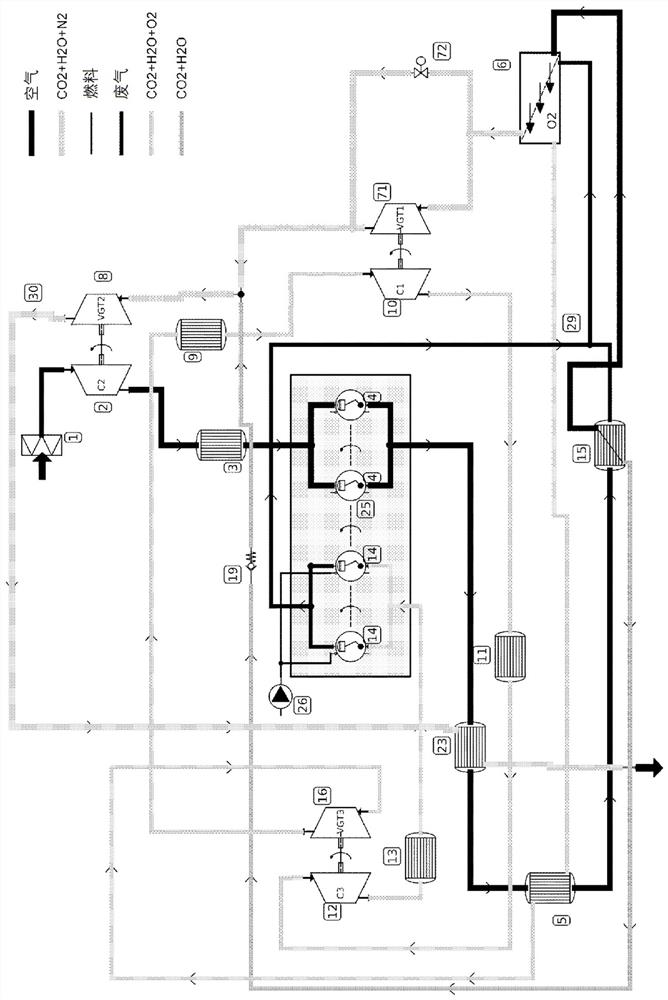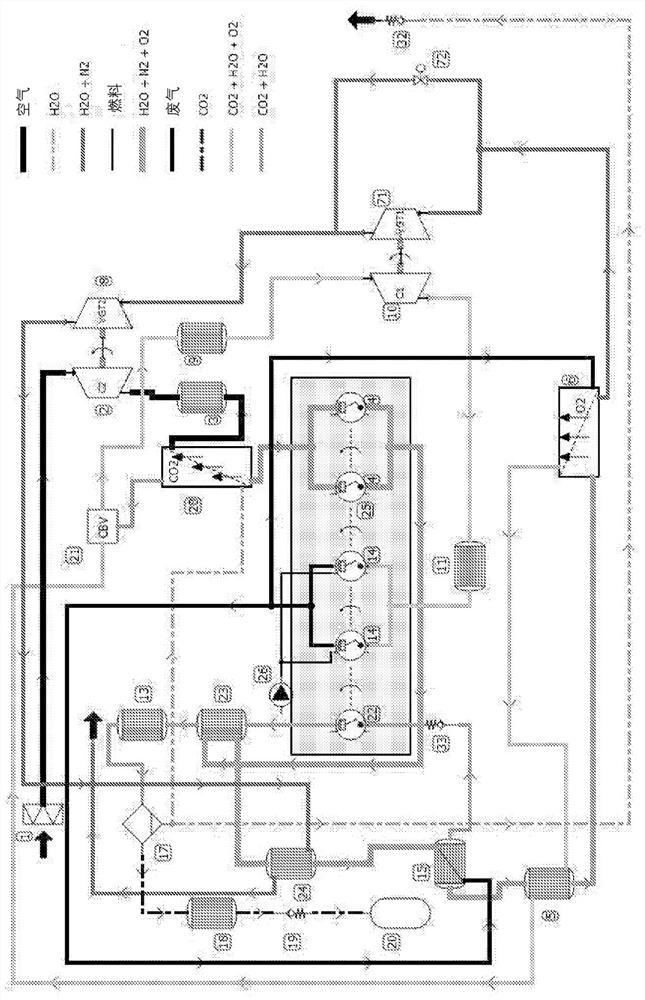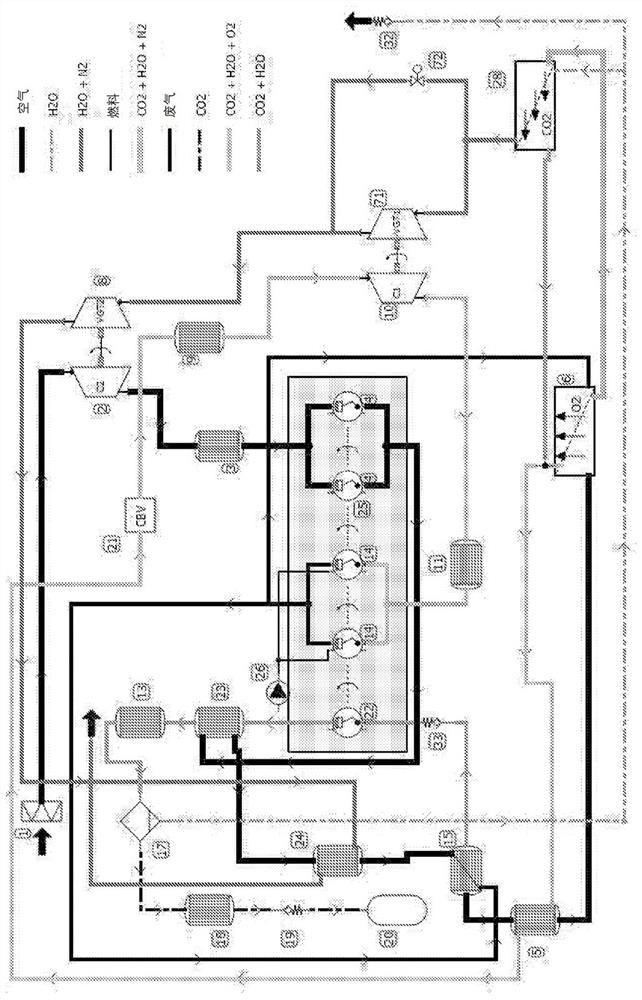Internal combustion engine and operating method of same
An internal combustion engine and fuel technology, applied to internal combustion piston engines, separation methods, combustion engines, etc., can solve the problems of gaseous atmosphere that is not conducive to molecular oxygen adsorption/desorption, reduces system efficiency, and has no catalytic activity.
- Summary
- Abstract
- Description
- Claims
- Application Information
AI Technical Summary
Problems solved by technology
Method used
Image
Examples
Embodiment 1
[0121] Example 1: Spark ignition (SI) engine with premixed mixture that emits no polluting gases and does not capture Get CO 2
[0122] Example 1 for having a premixed (homogeneous) mixture without capturing CO 2 spark ignition (SI) engines. Example 1 is based on a deflagration combustion process, with subsonic velocity and a mixture that cannot ignite spontaneously, for the generation of net mechanical power.
[0123] The degree of boost (charge) of the engine (percentage of maximum torque) is determined by the O in the MIEC membrane (6) 2 Spawn rate control. This reduces pumping losses as it eliminates the need for throttling butterfly valves to throttle the airflow.
[0124] By using CO from actual combustion and pre-cooling 2 and H 2 O dilutes the oxidant (O 2 ) and fuel (HxCyOz) mixture controls the combustion temperature. This prevents the use of fuel for this mission (standard practice for SI engines today).
[0125] Example 1 does not address the capture o...
Embodiment 2
[0143] Example 2: A spark ignition (SI) engine with a premixed mixture that emits no polluting gases and can Capture generated CO 2 and removal of atmospheric CO 2
[0144] Example 2 is for a spark ignition (SI) engine with a premixed (homogeneous) mixture that can capture atmospheric CO 2 and generated CO 2 . Therefore, it belongs to the removal of CO from the atmosphere 2 engine type (emission rate < 0). Example 2 is based on a deflagration combustion process with subsonic velocity and a mixture that cannot ignite spontaneously for the generation of net mechanical power.
[0145] The degree of boost (percentage of maximum torque) of the engine is determined by the O in the MIEC membrane (6) 2 Spawn rate control. This reduces pumping losses as it eliminates the need for throttling butterfly valves to throttle the airflow.
[0146] By using CO from actual combustion and pre-cooling 2 and H 2 O dilutes the oxidant (O 2 ) and fuel (HxCyOz) mixture controls the comb...
Embodiment 3
[0173] Example 3: Compression Ignition (CI) Engine with Stratified Mixture and Diffusion Combustion with Effectively Variable Compression Ratio by O 2 Formation rate control; no emission of polluting gases and capture of CO 2
[0174] Example 3 for having a stratified mixture (diffusion combustion) without emitting pollutants and capturing CO 2 compression ignition (CI) engines. For net mechanical power generation, Example 3 is based on a diffusion combustion process with deflagration of the premix and auto-ignition with a combustion rate controlled by the amount of movement of the fuel stream.
[0175] The degree of boost affects the percentage of maximum torque in each state through the effective compression ratio of the cycle. The effective compression ratio is variable and determined by the O in the MIEC membrane 2 Spawn rate control. This embodies the idea of downsizing, where the cylinder capacity of the engine can be reduced and the efficient compression pro...
PUM
| Property | Measurement | Unit |
|---|---|---|
| thickness | aaaaa | aaaaa |
Abstract
Description
Claims
Application Information
 Login to View More
Login to View More - R&D
- Intellectual Property
- Life Sciences
- Materials
- Tech Scout
- Unparalleled Data Quality
- Higher Quality Content
- 60% Fewer Hallucinations
Browse by: Latest US Patents, China's latest patents, Technical Efficacy Thesaurus, Application Domain, Technology Topic, Popular Technical Reports.
© 2025 PatSnap. All rights reserved.Legal|Privacy policy|Modern Slavery Act Transparency Statement|Sitemap|About US| Contact US: help@patsnap.com



